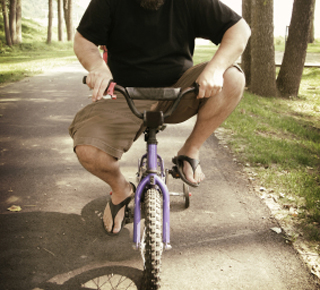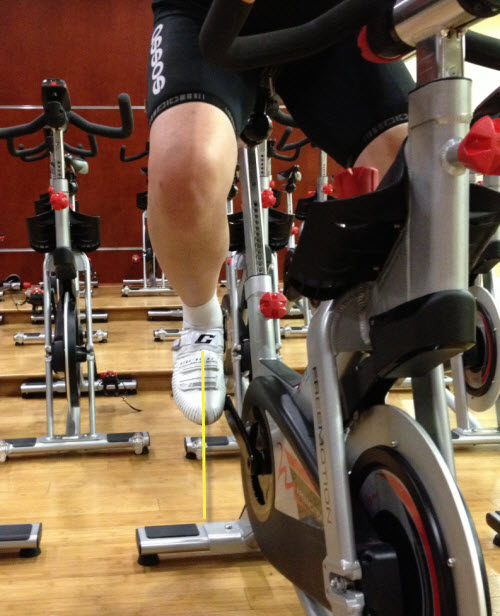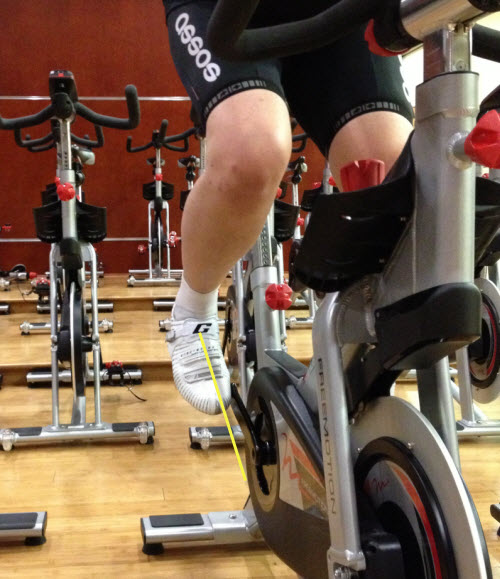
NOTE: I'll be publishing what I believe are the 10 Myths of Indoor Cycle Rider Setup / Bike Fit on Wednesdays each week, starting today with:
Myth #1 - It's proper, for you the instructor, to cue people to draw in their knees.
I cringe whenever I hear; "OK people, now I want everyone to bring in your knees!" because, for most of the riders in class, everyone's knees are already where they need to be. Please note that I didn't say where they should be, but where they need to be based on a number of different factors. Some are based on how the rider is fitted to the cycle and some are because...
Indoor Cycles are perfectly symmetrical - Humans, not so much...
You can find dozens of books and multiple business who focus on the art of fitting an imperfect cyclist to a perfect bicycle. Discussions of Leg Length Discrepancies, Feet Pronation, Q Factor and Cycling Shoe Cleat Wedges are beyond the scope of an Indoor Cycle Instructor helping a student with setup.
But there is one aspect of Indoor Cycle setup that has a huge influence on knee position, and yet is universally ignored*- foot alignment.
Take a minute and try his test on yourself: Stand on a smooth floor wearing your socks. Feet shoulder width apart, with a soft bend in your knees (like you should have on the bike). Now transfer the majority of your weight to the balls of your feet (like you're standing on the pedals) and rotate your heels inward. Notice where your knees go?
For most of us they move out, did they for you [wlm_firstname]?
Now let's see what happens when you arbitrarily decide; "my knees are sticking out, I need to bring them in." Go to the same position as before; soft bend, heels in, but now bring some of your weight back to your heels which will prevent your feet from moving (similar to how the pedal cages or cleats fix the position of your feet) and try to bring your knees in. What happened?
Because everything is connected (you remember the song; foot bone's connected to the ankle bone, the ankle bone's connected to the thigh bone, the thigh bone's connected to the knee bone, etc...) the position of your knee is exactly where it needs to be, based on your position on the cycle. If you have a student with improperly adjusted shoe cleats (or too low a saddle) and you tell them in your BIG INSTRUCTOR VOICE; "I want everyone to bring in your knees during this crushing 11 minute climb!" you could potentially hurt them over time. Worse, cause them to ignore the true reason their knees are out which for many people is simply having their heels rotated inward - like my buddy Randy demonstrates below.

Heels rotated in forces knees out

Feet aligned forward bring knees over pedal 🙂
There's actually a Sub- Myth here; the objective of proper bike fit isn't to just "bring in your knees". The objective is to get your knee pushing directly down on your pedal = the most efficient transfer of power with the least amount of stress on the most vulnerable joint in the system - your knees. We live in a three dimensional world, not two 🙁 So when while helping a student get set up, be sure to observe them from the front, as well as from the side.
So what to do and/or cue as the Instructor?
Jim Karanas gave us a beautiful cue during a class I took last week in San Francisco. He had us down in the drops (I realize your cycle may not have drops - Spinning Instructors can read this as comfortably in position 2) and asked that we look down and we should see our knees in the space between our arms. Nothing more. He was simply suggesting that we observe what was happening.
You haven't heard it yet, but I will be publishing an interview with Jay Blahnik in December where he makes a similar point about suggesting your students observe something and then let them act on it.
You may also pay attention to what you see in your students and identify excessive foot rotation. But be careful - some people are naturally very duck footed (or whatever the opposite of pigeon toed is where you live) so my suggestion is to ask "did you have someone set up your cleats? This may give you a clue to if they put any thought or care into attaching their cleats. You could also have them stand naturally in their socks on a smooth floor to see if there's anything weird and refer them to your local bike fit expert if necessary.
*There are 100's of YouTube videos explaining a multitude of different ways to properly fit someone to an Indoor Cycle, but not one that I'm aware of makes any comment or suggestions as to foot position and it's effect on knee position / alignment. Even the Spinning® Fit System ignores this topic beyond "... the cleats must be adjusted properly on the shoe. A good bike shop or bike fit specialist can help with this if needed." What "adjusted properly" means remains a mystery.
Read the rest of the 10 Myths of Indoor Cycle Rider Setup / Bike Fit
Originally posted 2012-11-21 12:19:18.
- Happy 75th Birthday Ed Hayes! - April 24, 2024
- Eagles pedaling through the air metaphor - April 21, 2024
- ICI Podcast 238 Meet Nerd Fitness Creator Steve Kamb - April 6, 2024

Looking forward to the Jay Blahnik interview, John…..
….but you’ve already given me enough right here to get my mind racing a bit.
My add on to asking students to *observe something and act on it* is to ask themselves why they’re not (acting on it, that is!) Now that’s the tough nut I’d like to crack.
Mind, starting from the *bottom up* is definitely the best place to begin.
Vivienne
This is related to one of my personal hobbyhorses: the shoes people wear to class and the effect on the whole chain. In modern athletic shoes (which many people purchase for looks, not function) the foot is encouraged to assume an un-natural position. This is then exacerbated, particuarly for people with larger feet, when they attempt to place the shoe on the pedal and fit it under the toe strap. Whenever anyone struggles with foot and/or knee issues I ask them to return in a less-structured shoe. Here on the coast many people have boat shoes. The soles aren’t stiff enough but the foot is allowed to fall where it should based on the relationships up the chain. They can immediately feel and see the difference (after a new bike fit). It isn’t long before they have purchased true cycling shoes and are asking for advice on cleat placement.
Yes, the whole chain is affected. Long ago, when I first came off the couch, I bought a pair of fitness shoes (very popular at walmart these days). When I ran I could get about 1/3 of a mile until getting a sharp pain in my rt knee. I asked a buddy of mine his ideas of fixing my knee and the first thing he asked was; “what are you wearing for shoes?” I went to the running store he suggested and learned I was very pronated (feet roll in) and required a running shoe with a lot of stability. Of course he recommended a very expensive shoe which he guaranteed would solve my knee pain. I’ve been running in Asics Kayano’s ever since 🙂
Thanks for debunking those myths. I learned a lot.
Just came across your site as I was looking for ways to help a new rider in my indoor cycling class. When she stands with her feet parallel, toes facing forward, her knees turn inward fairly dramatically. She said she had a lot of knee pain after her first class because she couldn’t prevent her knees from turning inward on the bike with her feet in the proper position. Do you have any thoughts or suggestions? She does not have cycling shoes to clip in, so she uses the cages with gym shoes. Thank you in advance!
Knees turning inward? That’s a new on me.
If she stands (on the floor) in front of you, do her knees naturally turn in?
You might ask her if she has “flat feet” = she’s pronated – where her arches are collapsed. That would cause her knees to naturally turn inward.
The solution (my problem as I describe in the article ) is to wear a shoe with a lot of arch support. They’re often labeled as ‘motion control’ shoes that prevent the foot from rolling inward. or a good pair of orthotic inserts
John just catching up on reading. To my surprise I see – “For most of us they move out, did they for you Spook?”
Stay well John
Our fancy software does that Spook! Mine says “John”.
Merry Christmas!